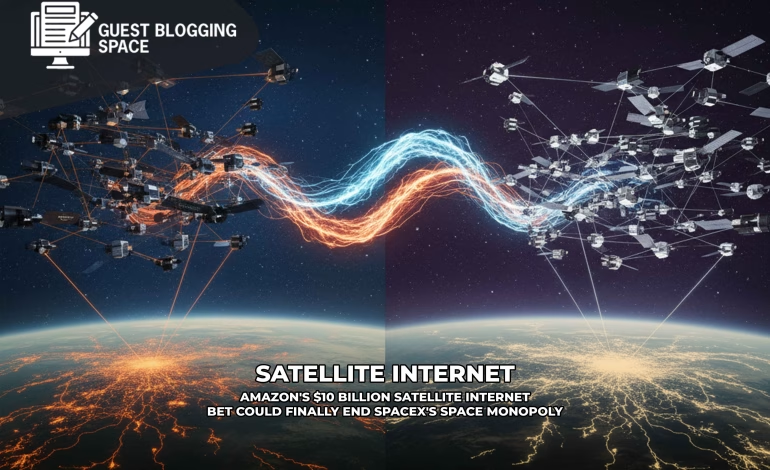Amazon Leo Ultra: The Shocking Satellite Internet Breakthrough That Could Destroy Starlink’s Dominance

Amazon Leo Ultra satellite internet has arrived, and it’s shaking up a market that SpaceX once dominated without serious competition. The tech giant just unveiled what it claims is the world’s fastest commercial satellite terminal, capable of delivering internet speeds that would make your home broadband jealous even from the middle of nowhere.
But here’s what makes this announcement different from typical Silicon Valley hype: Amazon isn’t trying to sell you a dish for your rooftop. Instead, the company is going after something far more ambitious rewiring how businesses, governments, and critical infrastructure connect to the digital world when traditional cables simply can’t reach.
Why This Launch Matters More Than You Think
Picture this: A cargo ship crossing the Pacific Ocean, maintaining real-time video calls with headquarters. An oil rig in the Gulf of Mexico streaming sensor data to AI systems that predict equipment failures before they happen. A rural hospital in Africa performing remote surgery consultations with specialists thousands of miles away. A disaster relief team coordinating rescue operations in the aftermath of a hurricane that destroyed every cell tower for hundreds of miles.
These scenarios aren’t science fiction anymore. Amazon just made them significantly more achievable with its Leo Ultra terminal announcement. The device promises something that seemed impossible just a few years ago genuine gigabit internet from space, with upload speeds fast enough to support professional video production, live broadcasting, and complex data transfers from the most remote locations on Earth.
Andy Jassy, Amazon’s CEO, couldn’t contain his excitement when breaking the news. He took to social media to declare that Leo Ultra represents the fastest satellite internet antenna ever manufactured, delivering simultaneous download speeds reaching 1 Gbps while maintaining upload speeds of 400 Mbps. That upload figure deserves emphasis because it’s where most satellite systems traditionally stumble.
The Technology That Makes It Possible
Understanding what makes Amazon Leo Ultra satellite internet special requires looking beyond the impressive speed numbers. The secret sauce lies in its custom-designed silicon and full-duplex phased array technology engineering terms that translate into something genuinely revolutionary.
Traditional satellite dishes physically move to track satellites across the sky. They’re mechanical, vulnerable to weather, and slow to adjust. Phased array technology eliminates moving parts entirely. Instead, it uses electronic beam steering, directing signals through sophisticated algorithms that can track multiple satellites simultaneously while the terminal sits completely still.
Amazon designed its own silicon specifically for this purpose. By controlling the entire hardware stack, from the antenna to the processing chips, the company can optimize every aspect of performance. The terminal measures just 20 inches by 30 inches and stands less than 2 inches tall, making it remarkably compact for the power it delivers.
What really sets this apart is weatherproof engineering. An integrated heat sink manages thermal stress without requiring active cooling, meaning no fans fail in dusty or wet environments. The entire unit can withstand extreme temperatures, sandstorms, torrential rain, and the corrosive salt air of maritime environments. Installation requires nothing more than a simple pole mount, allowing deployment teams to set up connectivity in hours rather than days or weeks.
Where Amazon Started and Where It’s Going
The journey to this moment began years ago under the code name Project Kuiper, named after the famous astronomer Gerald Kuiper and the distant belt of icy objects beyond Neptune. Amazon initially kept the project relatively quiet, working through regulatory approvals and engineering challenges while SpaceX’s Starlink grabbed headlines and market share.
November 2025 marked a strategic pivot. Amazon officially rebranded the entire initiative as Amazon Leo, embracing the low Earth orbit satellites that power the network. The name changes signals more than marketing it represents Amazon’s commitment to making this a flagship service, not an experimental side project.
More than 150 satellites currently orbit Earth as part of the constellation, with aggressive launch schedules planned to multiply that number rapidly. The company has secured launch contracts with multiple providers, including United Launch Alliance, with the next major deployment scheduled for mid-December. Each launch adds coverage, capacity, and redundancy to the network.
The Three-Tiered Strategy
Amazon isn’t putting all its eggs in one basket. The company revealed three distinct terminal models, each targeting different market segments and use cases.
Leo Nano sits at the entry level, featuring a compact 7-inch square antenna designed for basic connectivity needs. It delivers download speeds up to 100 Mbps, making it suitable for remote offices, recreational vehicles, or locations requiring reliable but not extreme bandwidth. Think of it as the connectivity option that gets you online competently without breaking the budget.
Leo Pro occupies the middle tier with an 11-inch antenna supporting download speeds up to 400 Mbps. This model targets mobile applications, vehicles, boats, aircraft—where space and weight matter but performance can’t be compromised. Early partners are already testing Leo Pro for fleet management, maritime operations, and mobile command centers.
Then comes Leo Ultra, the flagship that’s generating all the attention. Its 1 Gbps download and 400 Mbps upload capabilities place it in a different category entirely. This terminal aims to replace or supplement fiber connections in locations where fiber installation would cost millions or simply isn’t feasible. Think about remote mining operations, offshore platforms, military bases, and research stations in polar regions.
Real Companies, Real Applications
The announcement included several partnership reveals that demonstrate Amazon’s go-to-market strategy. These aren’t aspirational “we hope to work with” statements—they’re signed deals with companies actively testing the technology.
JetBlue Airlines has committed to deploying Amazon Leo Ultra satellite internet for in-flight connectivity. Anyone who’s tried to work on a plane knows that current systems range from barely functional to completely useless. JetBlue’s president explained that the airline specifically chose Amazon because of its reputation for customer-focused innovation and the technical capabilities needed to deliver genuinely fast, reliable Wi-Fi at 35,000 feet.
Hunt Energy Holdings, which operates energy assets globally, signed on for the secure private connectivity options. Their CEO emphasized that traditional internet simply isn’t secure enough for critical energy infrastructure. The ability to connect remote assets directly to private networks without touching the public internet addresses a fundamental security concern that has plagued the industry for decades.
Connected Farms, an agricultural technology company, sees opportunities to bring precision farming to operations that currently lack reliable connectivity. Imagine sensors monitoring soil moisture, crop health, and equipment status across thousands of acres, all feeding real-time data to AI systems that optimize irrigation, fertilization, and harvesting schedules. That requires consistent, high-speed connectivity even in areas where cell towers don’t exist.
Vanu, which builds distributed antenna systems, plans to use Leo to backhaul cellular traffic in underserved areas. This solves a classic chicken-and-egg problem: carriers won’t build towers where fiber doesn’t exist, but fiber providers won’t build to areas without population density. Satellite backhaul could finally break that cycle.
The AWS Advantage Nobody’s Talking About
Here’s where Amazon’s strategy gets genuinely clever: Leo Ultra doesn’t just provide internet—it integrates seamlessly with Amazon Web Services infrastructure. For companies already running operations on AWS, this creates a connectivity option that competitors simply cannot match.
The Direct to AWS feature allows remote assets to link straight to cloud workloads through AWS Transit Gateway or AWS Direct Connect Gateway. Data flows from the satellite terminal to Amazon’s ground stations and directly into the AWS cloud ecosystem, bypassing the public internet entirely. This architecture reduces latency, enhances security, and simplifies network management for enterprises with complex cloud deployments.
Private Network Interconnects take this further, enabling companies to connect satellite-linked systems directly to their own data centers at major colocation facilities. A mining company could link its remote operations site directly to its private network, treating the satellite connection as just another node in its wide-area network. The data never traverses the public internet, significantly reducing exposure to cyber threats.
For industries like defense, finance, healthcare, and critical infrastructure, this level of security and integration justifies premium pricing that consumer-focused competitors can’t command.
The Starlink Elephant in the Room
Any honest discussion about Amazon Leo Ultra satellite internet must acknowledge the 8,000-pound gorilla orbiting overhead: SpaceX’s Starlink network. The comparison is inevitable because Starlink fundamentally created the modern LEO satellite internet market.
SpaceX currently operates more than 8,000 active satellites serving roughly 8 million customers worldwide. The company has aggressively expanded into consumer, business, maritime, aviation, and mobile markets. Starlink has become synonymous with satellite internet in the same way Google became synonymous with search.
Amazon faces a significant challenge in overcoming that lead. 150 satellites versus 8,000 isn’t a gap—it’s a chasm. Starlink can offer global coverage today. Amazon’s network will take years to reach similar scale. Every month of delay allows SpaceX to add subscribers, refine technology, reduce costs, and strengthen its market position.
However, Amazon brings advantages Starlink doesn’t possess. The AWS ecosystem creates immediate value for enterprise customers already invested in Amazon’s cloud platform. Amazon’s supply chain expertise, honed through decades of running the world’s largest e-commerce operation, could drive hardware costs down faster than competitors expect. And Amazon’s deep pockets provide patient capital that can sustain losses during the infrastructure buildout phase.
The strategic difference is also worth noting: Starlink initially targeted consumers and has gradually moved upmarket. Amazon is starting with enterprises and governments, then may expand down market once the network matures. Starting at the top of the market potentially avoids the brutal price competition that characterizes consumer internet services.
What Nobody’s Saying: The Hard Questions
Despite the exciting announcement, several critical questions remain unanswered, and they’ll determine whether Amazon Leo Ultra satellite internet becomes a genuine industry force or an expensive experiment.
Pricing remains completely undisclosed. Without cost information, businesses can’t evaluate whether this makes financial sense. Will Leo Ultra terminals cost $5,000? $20,000? $50,000? Service fees could range anywhere from hundreds to thousands of dollars monthly. Until Amazon reveals its pricing strategy, potential customers are left guessing.
The timeline lacks specificity. “Broader rollout starting in 2026” could mean anything from January to December. Enterprise customers need concrete dates to plan deployments, budget cycles, and infrastructure transitions. Vague timelines create uncertainty that favors maintaining current solutions.
Coverage maps haven’t been published. Where exactly will the service work in 2026? Which regions get priority? How much capacity will be available in each geographic area? These details matter enormously for companies evaluating whether Leo can actually serve their specific locations.
Regulatory approvals remain incomplete in many countries. Building a global satellite network requires navigating dozens of different regulatory regimes, each with its own approval processes, spectrum allocations, and operational requirements. Delays in key markets could significantly impact the rollout schedule.
Competition extends beyond Starlink. Eutelsat’s OneWeb constellation targets similar enterprise markets with 648 satellites already operational. The European Union is funding its own secure satellite network called IRIS². Traditional geostationary operators like Viasat are fighting to remain relevant. Amazon isn’t entering a two-player market it’s diving into an increasingly crowded space.
The Environmental Equation
Launching thousands of satellites raises legitimate environmental and safety concerns that deserve more attention than they typically receive in breathless tech coverage.
Low Earth orbit is getting crowded. The more satellites companies launch, the higher the risk of collisions creating debris fields that make certain orbital bands unusable. The space industry calls this Kessler Syndrome a cascading collision scenario that could effectively lock humanity out of certain orbital regions for generations.
Amazon has committed to deorbiting satellites within months of their operational end-of-life, but even retired satellites add to the congestion during their controlled descent. The company is also developing lasers for inter-satellite communication to reduce the radio frequency pollution that can interfere with astronomical observations.
Light pollution from satellite constellations has already impacted astronomical research. Those strings of lights visible at dawn and dusk aren’t stars—they’re satellites reflecting sunlight. As constellations grow larger, astronomers warn that certain types of observations may become impossible from Earth’s surface, forcing even more expensive space-based telescopes.
These concerns don’t make satellite internet inherently bad, but they demand thoughtful engineering, responsible operations, and industry-wide coordination to prevent tragedy-of-the-commons outcomes in orbit.
What This Means for Average People
If you’re reading this and thinking “great, but when can I get gigabit satellite internet at my rural home,” the honest answer is: probably not soon, and maybe not ever at consumer prices.
Amazon is clearly prioritizing enterprises and government customers who can pay premium prices for premium performance. Consumer markets are brutally competitive with thin margins. Building out network capacity to serve millions of homes while competing with established players like Starlink requires capital and risk tolerance that Amazon may choose to avoid.
However, even if Leo Ultra never reaches average consumers directly, its impact will ripple through society. Better connectivity for remote medical facilities improves healthcare outcomes. Reliable internet for rural schools narrows educational opportunity gaps. Coverage for disaster response teams saves lives during emergencies. Enterprise deployments in underserved regions often catalyze broader infrastructure investments.
The competition itself benefits consumers. SpaceX must now justify its pricing against a legitimate competitor with deep pockets and strong technology. That competitive pressure could drive down costs, improve service quality, and accelerate innovation across the entire industry.
The Long Game
Amazon didn’t build the world’s most sophisticated logistics network overnight. The company’s strategy has always favored patient infrastructure investment over quarterly profit optimization. Leo represents the same approach applied to satellite connectivity.
Success won’t be measured in 2026 subscriber counts. Instead, watch for enterprises that integrate Leo connectivity into critical infrastructure, government agencies that standardize on Amazon for secure communications, and industries that develop new business models enabled by ubiquitous satellite connectivity.
The interesting question is whether Amazon can do to satellite internet what it did to cloud computing with AWS—define the market, set the standards, and capture the most valuable customers before competitors realize what happened.
What Happens Next
Amazon has begun delivering its Leo Pro and Leo Ultra terminals to companies participating in its enterprise preview program. This phased rollout helps Amazon collect real-world performance data, fine-tune the hardware, improve network operations, and shape industry-specific solutions before fully scaling access to Amazon Leo Ultra satellite internet.
The United Launch Alliance launch planned for December 15 will add another important group of satellites to the growing network, boosting both coverage and overall capacity. Amazon is pushing for an aggressive launch schedule through 2026, aiming to place several hundred satellites into orbit by the end of the year — a pace designed to strengthen the foundation of Amazon Leo Ultra satellite internet as it continues to expand.
As Amazon ramps up its momentum, the marketing push will accelerate as well. You’ll start seeing real-world case studies of successful deployments, new enterprise partnerships, and eventually clearer, consumer-friendly messaging as the network grows. Amazon knows that winning this space takes far more than strong engineering—it requires building a full ecosystem, supporting developers, and creating the kind of network effect where Amazon Leo Ultra satellite internet naturally becomes the go-to choice.
FAQs
Q: When can regular consumers get Amazon Leo Ultra satellite internet?
A: Amazon hasn’t announced consumer availability yet. The company is focusing on enterprise and government customers first, with broader consumer rollout potentially coming in late 2026 or 2027.
Q: How much will Amazon Leo Ultra cost?
A: Pricing hasn’t been disclosed. Based on the enterprise positioning and hardware specifications, expect premium pricing significantly higher than consumer satellite services.
Q: How does Leo Ultra compare to Starlink in speed?
A: Leo Ultra claims 1 Gbps downloads and 400 Mbps uploads, while Starlink’s business service typically delivers around 200-400 Mbps downloads with 25 Mbps uploads. However, Starlink has far more satellites and coverage.
Q: Do I need to use AWS to benefit from Leo Ultra?
A: No, but AWS customers get special integration features like Direct to AWS and private network interconnects that bypass the public internet entirely.
Q: How many satellites do Amazon have in orbit?
A: Amazon currently has over 150 satellites operational, with aggressive expansion plans to reach thousands of satellites over the next few years.
Read More:
Google’s Top 5 Most Powerful SEO Tools in 2025 to Skyrocket Your Rankings









